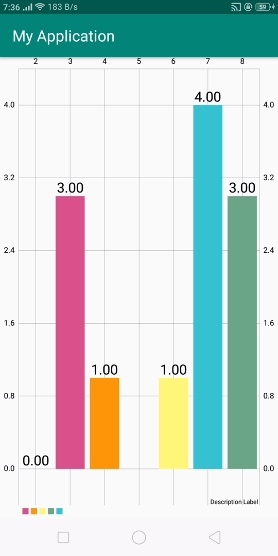
 Data Structure
Data Structure Networking
Networking RDBMS
RDBMS Operating System
Operating System Java
Java MS Excel
MS Excel iOS
iOS HTML
HTML CSS
CSS Android
Android Python
Python C Programming
C Programming C++
C++ C#
C# MongoDB
MongoDB MySQL
MySQL Javascript
Javascript PHP
PHP
- Selected Reading
- UPSC IAS Exams Notes
- Developer's Best Practices
- Questions and Answers
- Effective Resume Writing
- HR Interview Questions
- Computer Glossary
- Who is Who
How to use Bar chart graph in android?
This example demonstrates How to use Bar chart graph in android.
Step 1 − Create a new project in Android Studio, go to File ⇒ New Project and fill all required details to create a new project.
Step 2 − Open build.gradle(module level) and add library dependency.
apply plugin: 'com.android.application'
android {
packagingOptions {
exclude 'META-INF/proguard/androidx-annotations.pro'
}
packagingOptions {
exclude 'META-INF/DEPENDENCIES'
exclude 'META-INF/LICENSE'
exclude 'META-INF/LICENSE.txt'
exclude 'META-INF/license.txt'
exclude 'META-INF/NOTICE'
exclude 'META-INF/NOTICE.txt'
exclude 'META-INF/notice.txt'
exclude 'META-INF/ASL2.0'
}
compileSdkVersion 28
defaultConfig {
applicationId "com.example.andy.myapplication"
minSdkVersion 15
targetSdkVersion 28
versionCode 1
versionName "1.0"
testInstrumentationRunner "android.support.test.runner.AndroidJUnitRunner"
}
buildTypes {
release {
minifyEnabled false
proguardFiles getDefaultProguardFile('proguard-android.txt'), 'proguard-rules.pro'
}
}
}
dependencies {
implementation fileTree(dir: 'libs', include: ['*.jar'])
implementation 'com.android.support:appcompat-v7:28.0.0'
implementation 'com.android.support.constraint:constraint-layout:1.1.3'
implementation 'com.github.PhilJay:MPAndroidChart:v3.1.0-alpha'
testImplementation 'junit:junit:4.12'
androidTestImplementation 'com.android.support.test:runner:1.0.2'
androidTestImplementation 'com.android.support.test.espresso:espresso-core:3.0.2'
}
Step 3 − Open build.gradle(application level) and add library dependency.
// Top-level build file where you can add configuration options common to all sub-projects/modules.
buildscript {
repositories {
google()
jcenter()
}
dependencies {
classpath 'com.android.tools.build:gradle:3.2.1'
// NOTE: Do not place your application dependencies here; they belong
// in the individual module build.gradle files
}
}
allprojects {
repositories {
google()
jcenter()
maven { url 'https://jitpack.io' }
}
}
task clean(type: Delete) {
delete rootProject.buildDir
}
Step 4 − Add the following code to res/layout/activity_main.xml.
<?xml version = "1.0" encoding = "utf-8"?>
<android.support.constraint.ConstraintLayout xmlns:android = "http://schemas.android.com/apk/res/android"
xmlns:app = "http://schemas.android.com/apk/res-auto"
xmlns:tools = "http://schemas.android.com/tools"
android:layout_width = "match_parent"
android:layout_height = "match_parent"
tools:context = ".MainActivity">
<com.github.mikephil.charting.charts.BarChart
android:id = "@+id/BarChart"
android:layout_width = "fill_parent"
android:layout_height = "fill_parent" />
</android.support.constraint.ConstraintLayout>
In the above code, we have taken the Bar Chart view to show a Bar chart
Step 4 − Add the following code to src/MainActivity.java
package com.example.andy.myapplication;
import android.graphics.Color;
import android.os.Bundle;
import android.support.v7.app.AppCompatActivity;
import com.github.mikephil.charting.charts.BarChart;
import com.github.mikephil.charting.data.BarData;
import com.github.mikephil.charting.data.BarDataSet;
import com.github.mikephil.charting.data.BarEntry;
import com.github.mikephil.charting.utils.ColorTemplate;
import java.util.ArrayList;
public class MainActivity extends AppCompatActivity {
BarChart barChart;
BarData barData;
BarDataSet barDataSet;
ArrayList barEntries;
@Override
protected void onCreate(Bundle savedInstanceState) {
super.onCreate(savedInstanceState);
setContentView(R.layout.activity_main);
barChart = findViewById(R.id.BarChart);
getEntries();
barDataSet = new BarDataSet(barEntries, "");
barData = new BarData(barDataSet);
barChart.setData(barData);
barDataSet.setColors(ColorTemplate.JOYFUL_COLORS);
barDataSet.setValueTextColor(Color.BLACK);
barDataSet.setValueTextSize(18f);
}
private void getEntries() {
barEntries = new ArrayList<>();
barEntries.add(new BarEntry(2f, 0));
barEntries.add(new BarEntry(4f, 1));
barEntries.add(new BarEntry(6f, 1));
barEntries.add(new BarEntry(8f, 3));
barEntries.add(new BarEntry(7f, 4));
barEntries.add(new BarEntry(3f, 3));
}
}
Let's try to run your application. I assume you have connected your actual Android Mobile device with your computer. To run the app from the android studio, open one of your project's activity files and click Run play.jpg icon from the toolbar. Select your mobile device as an option and then check your mobile device which will display your default screen –

In the above result, it is showing the Bar chart as per our data set values.
Click here to download the project code

